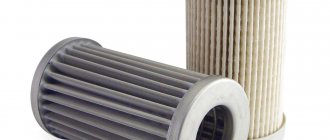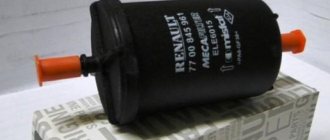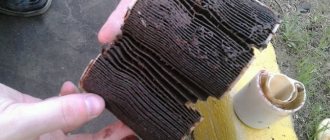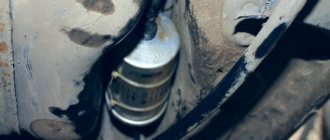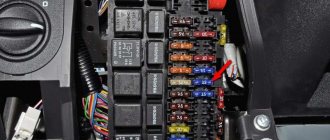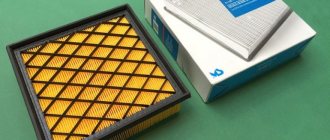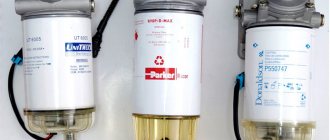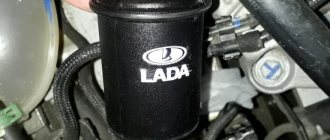Any car works due to the transformation of energy that is released during the combustion of the combustible mixture. Thanks to the vehicle's power system, fuel, as part of the combustible mixture, enters the cylinders. To ensure proper operation of this system, the fuel must be free of various impurities, as they can cause the power system to fail. Also, mechanical impurities have abrasive properties, which threatens damage to some injector components.
If the car's power system is injection, then mechanical impurities can damage or bind the precision pairs with which gasoline is dosed in the car. Their breakdown, therefore, leads to the failure of the injector. The diesel power system is most vulnerable to the presence of mechanical impurities in the fuel, since precision vapors are also present in the high-pressure fuel pump. Consequently, any vehicle power system must be equipped with fuel filters, the main purpose of which is to clean the fuel from mechanical impurities.
How does a fuel filter work?
Fuel filtration on modern cars is two-stage. In front of the fuel pump, a fine nylon receiving mesh screens out contaminant particles. And then the final screening of particles larger than 10 microns (for gasoline) is carried out by a fine filter.
The fuel module of the Lada 4x4 consists of a mesh fuel receiver and a fuel pump.
The fuel module of the Lada 4x4 consists of a mesh fuel receiver and a fuel pump.
What will happen when driving with an old filter?
If clogged, the filter will lose its ability to perform its main function - to clean the fuel, so the fuel mixture injection nozzles and the entire power system will become clogged, and the required amount of normal fuel will not flow into the engine itself.
Fuel that has not undergone proper cleaning will burn out not evenly, but in fragments, and will begin to settle on the pistons, cylindrical partitions, and spark plugs. A fuel mixture containing heavy metals and other particles, as a result of combustion products entering the exhaust system through accelerators and a lambda probe, will begin to gradually reduce the service life of all these elements.
It cannot be said that a clogged filter directly affects fuel consumption. However, the increase in fuel consumption, which is observed in this case, will lead to a decrease in power. As a result, for normal use of the vehicle you will have to press the gas harder, which, in fact, requires more gasoline or diesel. Therefore, a clogged filter for the fuel mixture, without directly affecting gasoline consumption, leads to an increase in this parameter.
Thus, it is necessary to constantly monitor the condition of the fuel filter and, if signs of clogging appear, immediately replace the spare part, since its further use is guaranteed to lead to serious problems with engine operation, the solution of which requires significant material costs.
It should also be noted that the process of replacing the cleaning element itself is not at all difficult; if you have the appropriate skills, you can do everything yourself. You can also always seek help from professionals who will do everything quickly and efficiently.
Where is the fuel filter installed?
As for the location of the fine filter, automakers' opinions have changed over time. In the beginning, all filters were installed under the car's underbody or in the engine compartment and were easily accessible for replacement.
Fuel filter under the bottom of the car with threaded ends. |
The plastic fuel filter is connected to the power system with quick-release tips. |
Then (increasingly) the filter began to be installed in the fuel module. This solution is, of course, more compact and convenient for cars. But replacing the filter is either not provided at all, but only as part of the module, or it involves a large amount of work to dismantle and completely disassemble the module. Moreover, the fuel module of some cars cannot be removed without dismantling the tank, and this is an even more ambitious task.
Fuel module with built-in filter. |
After completely disassembling the module, it is possible to remove and replace the fuel filter. |
About internal combustion engine power systems
Let’s return to the motor triad “clean oil, clean air, clean fuel.” We have already talked about filtering engine oil and air, now it’s the turn of fuel.
Fuel filters are the most important components of the engine power system. But first, let's remember what these systems are. Let's start with the gasoline engine.
Good old carburetor. This is, of course, history. But history is alive - just look at the old Zhiguli and Volga cars on our roads. And a lot of carburetor foreign cars were imported at one time. But one way or another, there is a demand for carburetor filters, both here and abroad.
Gasoline injection into the intake manifold. Sometimes it is called distributed injection. Fuel is supplied by injectors at a main pressure of 3–4 bar. The pressure in the system is created by the central fuel pump and maintained by the pressure reducing valve. The pump is located in the fuel tank, under the bottom or under the hood.
Injection of gasoline into the combustion chamber. Another name is direct injection. Here, two circuits are involved in the fuel line - low and high pressure. The pressure in the first reaches 3–4 bar and is created by the same central pump. But another electric pump is built into the low-pressure circuit, feeding the second circuit. From it, fuel under a pressure of 120 bar is supplied to a hydraulic accumulator connected to the injectors.
In both cases, the fuel filters are in the lines under a pressure of 3-4 bar. But with direct injection, the filter requires more subtle cleaning, and we will talk about this later.
Single-point injection can be considered a transitional option from the carburetor to the injectors. The requirements for it are less stringent than for distributed injection and, as a rule, are not considered separately.
Let's move on to diesel systems. Here the fuel can be injected into the prechamber or directly into the cylinder. To achieve efficient combustion, almost all modern diesel engines have fuel injected into the cylinder.
High pressure fuel pumps (HPFP) are the oldest, if you like, classic diesel system. There are also more modern solutions - pump injectors and Common Rail.
An injector pump is a unit that combines a pump, a magnetic valve to control injection and a sprayer for each individual cylinder. This system allows injection pressures of up to 2000 bar to be achieved.
The Common Rail system has a common accumulator - a pipe, often called a rail or fuel rail. From the pipeline, fuel is injected into the cylinders by injectors. Thanks to radial piston pumps, rail pressure can reach 1600 bar or more. The latest systems develop pressures of up to 2500 bar.
With the advent of modern gasoline and diesel injection systems, the requirements for fuel purity have increased significantly. Moreover, they are constantly becoming tougher. How many foreign inclusions need to be detained? This is what the author was told at the leading Russian institute FSUE NAMI.
Gasoline filtration requirements:
• 5–25% – for outdated carburetor systems (polluting particles 3–5 microns);
• 25–65% – for distributed injection systems (particles 3–5 microns);
• 48–70% – for traditional direct injection systems (particles 3–5 μm);
• 85–95% – for the latest direct injection systems (particles 3–5 microns);
Requirements for diesel fuel filtration:
• 25–65% – for old-style motors (pollutant particles 3–5 microns);
• 85–95% – for new Common Rail systems (particles 3–5 microns);
• 98% – for the latest Common Rail systems (2 micron particles).
In this case, the material must separate at least 95% of water from the fuel.
For today's automotive practice, some of the figures look exaggerated. In fact, they are promising and should be strived for. But in any case, these data correlate well with the infographics of MS Motorservice International and KOLBENSCHMIDT, presented in the figure below. And the listed problems are successfully solved through the use of the latest single-layer and multi-layer filter materials.
Diesel fuel filter
So far we have been talking about gasoline filters. Diesel fuel filters are always installed separately from the fuel tank, because, in addition to more frequent replacement, they also need water sensors, a water drain plug and, often, a heating system.
Fuel filters for diesel engines.
Fuel filters for diesel engines.
Gasoline injection filters
As already mentioned, injectors are very demanding regarding the purity of gasoline. Another feature of injection engines is the relatively high pressure in the power system. Naturally, the filter installed after the electric fuel pump must have a safety margin. Therefore, during testing, such filters are exposed to pressure up to 1.5–2 MPa (15–20 atmospheres).
The gasoline injection filter is installed in the tank, under the bottom or under the hood. The environment under the hood is aggressive. High temperatures and vapors of operating fluids reign here. This means that filter designers must take care of the corrosion resistance of its “body”. If the filter serves under the bottom, the issue of corrosion becomes especially relevant. Therefore, its body is made of galvanized steel, aluminum alloy or especially durable plastic.
And another interesting detail. A metal fuel filter housing is not easy to make. This is not just stamping, but so-called deep drawing, which requires the strictest technological discipline. And the greater the ratio of body length to diameter, the more difficult it is to ensure uniform wall thickness. When picking up a branded product, it’s useful to remember this.
A filter curtain is placed in the filter housing. Sometimes it is laid in a star pattern - in the KOLBENSCHMIDT documentation such filters are called radial (see illustration above). Indeed, the fuel passes along the radius of the curtain to the inner reinforcing tube. Along the way, dirt particles settle on the surface of the paper and deep in the pores, and the purified fuel rushes through the holes in the inner tube to the outlet of the filter.
But there is another way to style curtains - spiral-fold. KOLBENSCHMIDT specialists call such filters axial (axial). The filtration principle here is somewhat different than in radial filters.
Look at the picture on the previous page. Filter paper, thinner than a radial filter, is wound around the inner amplifier tube. But it is wound in a very clever way - so that V-shaped pockets are formed along the axis of the filter, capable of collecting dirt particles. The fuel is also fed along the axis, cleaned in the pockets and exits the filter through the central tube.
Spiral-fold laying allows you to place 1.5–1.7 times more material in the same volume than when laying with a star. At the same time, the paper for axial filtration differs from the paper used for the star - it is not smooth, but creped, “crumpled”. Experiments have shown that crepe retains more dense mechanical impurities.
Surprisingly, crepe paper is cheaper than regular paper. The explanation is simple - its impregnation is carried out at the stage of preparing the “mass” in the mixer, in contrast to the impregnation of the finished paper web. This means that manufacturers of such filters can pursue a more flexible pricing policy - an important opportunity during a crisis.
What happens if the fuel filter is clogged?
The filters are, of course, damaged by the dirt that gets into the tanks of our cars along with the fuel. And it’s not the oil refineries that are to blame. Fuel can become contaminated during storage and transfer. And the driver will feel the clogging of the fuel filter by the behavior of the car, and first in those modes where the instantaneous fuel consumption of the engine is maximum. These are driving modes at high speeds and intense acceleration. In this case, the engine will lose traction and operate intermittently, although at idle and in “quiet” modes everything will look decent.
Diesel fuel filters
According to statistics from FSUE NAMI, from 30 to 45% of diesel engine failures occur due to malfunctions of fuel equipment. This is truly a precision system - it is not without reason that the highest requirements for fuel purification are placed on it.
The classic FS diesel filter from KOLBENSCHMIDT is shown in the figure on this page. Much of what was said in the previous sections is also true for diesel filtration: power system diagrams, filter types, curtain design. Therefore, we will not repeat ourselves. Let’s just add that spiral-pleated installation is increasingly being used in diesel filters. This design is the last word in modern fuel purification systems.
In addition, sensors for the presence of water, pressure and temperature control, heating and water separation systems, faucets for draining sludge and other combinations of useful devices are built into the design of diesel filters.
By the way, about water in fuel, this headache for diesel drivers. How is moisture separation carried out? There's no secret. We just haven’t told you everything about crepe filter paper. A curtain made from this material helps combat water contained in the fuel. In a situation where ordinary paper is clogged with moisture, crepe paper allows this moisture to pass through, but not immediately, but as local pressure increases. At the exit from the pores, moisture flows in large drops onto the inner wall of the housing or into a sump, if one is provided for in the filter design. The driver opens a special tap and lets the water drain. In a word, a simple operation, especially since in some cars the water level is determined by a special sensor.
Since Common Rail diesel injection systems are precision and high-tech, at the time of the first (attention - the very first!) engine start, no dirt that got into the filter during assembly should penetrate into the fuel equipment. Therefore, this assembly takes place in a special Clean Room workshop. Here the filters are packaged, sealed and delivered to distributors in this form.
The author had the opportunity to visit such workshops. The Clean Room employs specially trained staff. Special shoes, a white uniform, sterile caps and gloves are required. The room itself is certified in accordance with the International Standard EN ISO 14644. Dust simply does not have a chance to survive in the “white zone” of a clean room.
How often should the fuel filter be changed?
The frequency of routine filter replacement is primarily determined by the vehicle manufacturer. For some manufacturers this is 30,000 km, for others - 120,000 km. Moreover, frequent replacements are usually recommended by manufacturers who place the filter outside the fuel tank. You should only change the fuel filter ahead of schedule if you are sure that foreign mechanical particles or a large amount of water have entered the tank. In this case, you should also rinse the tank and possibly replace the fuel pump.
Diesel engine fuel filters have the most difficult time in winter: after all, thickened fuel must pass through the filter material. That is why it is better to carry out preventive filter replacement on a diesel car in the fall. This is due to the fact that the filter capacity, already reduced by clogging with solid particles, will be insufficient to pass the cold, thickened fuel.
Frequency of replacement of gasoline filters of some manufacturers, thousand km:
- Volkswagen 30 (remote filters)
- Renault 120
- Kia 60
- Hyundai 60
- Lada 30 (remote filters), 120 (built-in filters)
Some tips for replacing the fuel filter:
- Refuel at proven, or even better, branded gas stations.
- Try not to pour fuel into the tank immediately after the fuel has been drained from the tanker at a gas station, because the fuel in the tank is agitated and dirt is more likely to get in.
- Do not pour fuel into old, rusty cans.
- Change fuel filters on time - then a malfunction will not catch you on a long journey.
- Wash the fuel intake strainer at the pump inlet: this will extend its service life.
Tell us in the comments if you have encountered problems related to fuel filters? Good luck on the roads everyone!
Fuel filter: should I change it or will it do the same?
Why do we filter?
Unfortunately, gasoline begins to become contaminated from the moment it is “born” at the refinery. Transportation of fuel in tanks also makes a contribution - they “breathe”, which means they allow dust to pass through.
Gasoline also becomes contaminated at gas stations, where dust enters the tank along with the fuel stream. And if the tank is not sealed, dust will be sucked into it continuously. And the tank itself may have scale and pockets of corrosion inside. And although iron oxides are significantly softer than, for example, quartz dust, they cannot be discounted.
The nature of pollution also depends on the region. Quartz dust is a problem in central Russia. In the southern regions of the country and in Western Siberia, another dust predominates - loess. This is a product of grinding loose rocks, containing, in addition to quartz, feldspar and clay minerals. Loess dust is softer than quartz, but this advantage is compensated by its large amount, which also leads to rapid contamination of the fuel.
The same is true for diesel fuel. Organic and mechanical impurities, as well as water, appear in it. Running a diesel engine on such fuel leads to corrosion of fuel equipment, accelerated wear of the cylinder-piston group, loss of power and other unpleasant consequences.
In cold weather, operators face additional troubles - paraffins precipitate in diesel fuel, clogging filters. To combat this phenomenon, heated filter elements are produced, in particular with a curtain made of conductive paper. Now let's move on to filtering.
How to make a choice
When choosing a fuel filter, you should pay attention to:
- Device bandwidth. The coincidence of the diameters of the filter inlet and outlet fittings with the diameter of the fuel pipe tube is a sure sign of suitability, but it never hurts to clarify the parameters;
- Filter service life declared by the manufacturer. Avoid purchasing fuel filters, the manufacturers of which guarantee the constant performance of the device throughout the entire service life of the vehicle;
- Manufacturer's reputation. Little-known manufacturers can place a plastic mesh wrapped in a blotting cloth in the filter, sell the batch at a dumping price - and disappear from the market forever.
Purchasing a new item
When choosing this element, be sure to pay attention to the following parameters:
- filtration level. If it is insufficient and large particles nevertheless penetrate into the system along with the fuel, this will very quickly lead to engine failure;
- the area of the filtration element, as well as the presence of a rubber seal that covers the entrance to the filter itself. If there is none, this part will be very problematic to replace.
Depending on the fuel system, fine filters are divided into:
- carburetor, permissible degree of purification is 15-20 microns (smaller particles will pass into this system, but will not harm the fuel delivery system to the engine);
- injection, finer degree of purification, 5-10 microns (in such systems, the requirements for the maximum size of permissible contamination are higher, i.e. the injector can become clogged with larger particles, so the holes in the filter are smaller);
- diesel engines are capable of retaining not only very small solid particles (less than 5 microns), but also removing moisture, and this is very important for a diesel engine.
When purchasing, it is important to tell the seller the make and year of your car in order to choose the right filter. For the most part, if there is no product specifically for your case, then you can choose something interchangeable. But there are cases where this is not possible, so check your vehicle's manual for this information.
